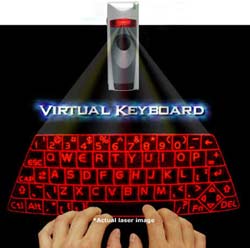 A virtual keyboard created entirely by light. Because of this, it can be projected onto any flat surface, making it a highly space-efficient concept. A dual infrared sensor captures the signals of the keystrokes as users interact with it.
A virtual keyboard created entirely by light. Because of this, it can be projected onto any flat surface, making it a highly space-efficient concept. A dual infrared sensor captures the signals of the keystrokes as users interact with it.
The arrangement of the keys has been standardized to QWERTY since the first keyboard was created and remains the same today.
Voice recognition software is becoming more powerful and intelligent. Many keyboards will be completely replaced by microphones.
Characters appear on the screen of a personal digital assistant (PDA).
Visible light creates the image of a keyboard.
How Does a Virtual Keyboard Work?
Handheld digital devices like PDAs or mobile phones often have small buttons, making them challenging to use for extensive typing. Dialing a phone number or sending a short text is easy, but composing a long email can become inconvenient with small keys. A virtual keyboard addresses these issues. A small projector displays an image of the keyboard on any flat surface, such as a suitcase lid. The internal sensor in the projector detects the user’s keystrokes, turning them into characters on the screen. To create a real keyboard feel, the projector emits clicking sounds during use.
How is a keystroke on a virtual keyboard displayed on the screen?
1. A laser beam projects the image of a virtual keyboard onto a flat surface.
2. An infrared beam is projected above the keyboard.
3. The finger performs the keystroke action. This action affects the infrared beam, and the infrared light reflects changes back to the projector.
4. The reflected infrared beam passes through an infrared filter to the camera.
5. The camera receives the reflected infrared light, calculates the angle, and constructs the image of the characters.
6. The sensor chip identifies the broken points of the infrared beam caused by the user’s keystroke. It then converts the broken images to coordinates.
7. The final characters are rendered on the device screen using the pre-constructed coordinates transmitted via wireless connection.
The expanded infrared beam is projected above the virtual keyboard.
A virtual keyboard is created using both visible and invisible light. The visible light projects the image of the keyboard onto the surface, while the invisible light is responsible for detecting the user’s keystroke actions. When the infrared beam is disrupted (due to a keystroke), the internal sensor of the projector identifies which key has been pressed.


















































